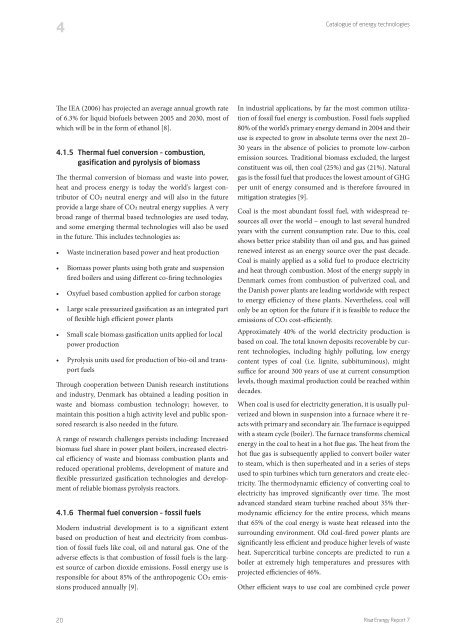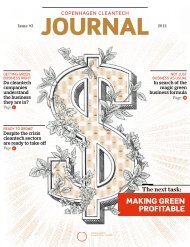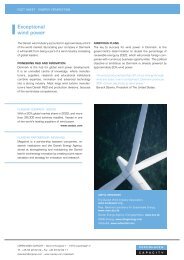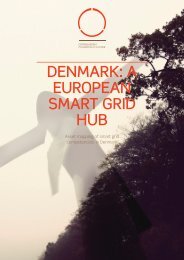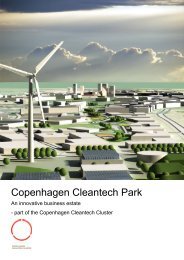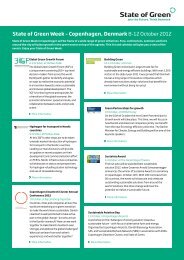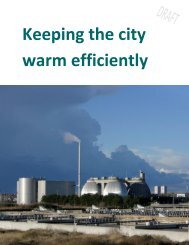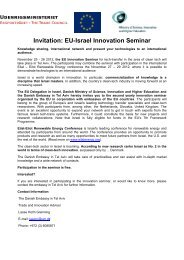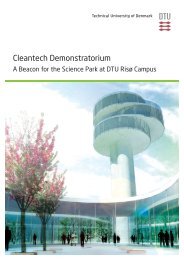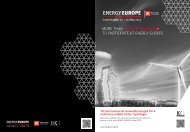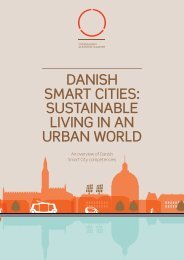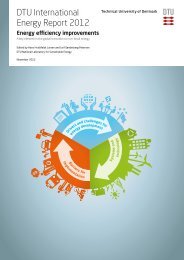Future low carbon energy systems - Copenhagen Cleantech Cluster
Future low carbon energy systems - Copenhagen Cleantech Cluster
Future low carbon energy systems - Copenhagen Cleantech Cluster
You also want an ePaper? Increase the reach of your titles
YUMPU automatically turns print PDFs into web optimized ePapers that Google loves.
4Catalogue of <strong>energy</strong> technologiesThe IEA (2006) has projected an average annual growth rateof 6.3% for liquid biofuels between 2005 and 2030, most ofwhich will be in the form of ethanol [8].4.1.5 Thermal fuel conversion – combustion,gasification and pyrolysis of biomassThe thermal conversion of biomass and waste into power,heat and process <strong>energy</strong> is today the world's largest contributorof CO2 neutral <strong>energy</strong> and will also in the futureprovide a large share of CO2 neutral <strong>energy</strong> supplies. A verybroad range of thermal based technologies are used today,and some emerging thermal technologies will also be usedin the future. This includes technologies as:fired boilers and using different co-firing technologiesof flexible high efficient power plantspower productionport fuelsThrough cooperation between Danish research institutionsand industry, Denmark has obtained a leading position inwaste and biomass combustion technology; however, tomaintain this position a high activity level and public sponsoredresearch is also needed in the future.A range of research challenges persists including: Increasedbiomass fuel share in power plant boilers, increased electricalefficiency of waste and biomass combustion plants andreduced operational problems, development of mature andflexible pressurized gasification technologies and developmentof reliable biomass pyrolysis reactors.4.1.6 Thermal fuel conversion – fossil fuelsModern industrial development is to a significant extentbased on production of heat and electricity from combustionof fossil fuels like coal, oil and natural gas. One of theadverse effects is that combustion of fossil fuels is the largestsource of <strong>carbon</strong> dioxide emissions. Fossil <strong>energy</strong> use isresponsible for about 85% of the anthropogenic CO2 emissionsproduced annually [9].In industrial applications, by far the most common utilizationof fossil fuel <strong>energy</strong> is combustion. Fossil fuels supplied80% of the world’s primary <strong>energy</strong> demand in 2004 and theiruse is expected to grow in absolute terms over the next 20–30 years in the absence of policies to promote <strong>low</strong>-<strong>carbon</strong>emission sources. Traditional biomass excluded, the largestgas is the fossil fuel that produces the <strong>low</strong>est amount of GHGper unit of <strong>energy</strong> consumed and is therefore favoured inmitigation strategies [9].Coal is the most abundant fossil fuel, with widespread resourcesall over the world – enough to last several hundredyears with the current consumption rate. Due to this, coalshows better price stability than oil and gas, and has gainedrenewed interest as an <strong>energy</strong> source over the past decade.Coal is mainly applied as a solid fuel to produce electricityand heat through combustion. Most of the <strong>energy</strong> supply inDenmark comes from combustion of pulverized coal, andthe Danish power plants are leading worldwide with respectonly be an option for the future if it is feasible to reduce theemissions of CO2 cost-efficiently.Approximately 40% of the world electricity production isbased on coal. The total known deposits recoverable by currenttechnologies, including highly polluting, <strong>low</strong> <strong>energy</strong>content types of coal (i.e. lignite, subbituminous), mightsuffice for around 300 years of use at current consumptionlevels, though maximal production could be reached withindecades.When coal is used for electricity generation, it is usually pulverizedand b<strong>low</strong>n in suspension into a furnace where it reactswith primary and secondary air. The furnace is equippedwith a steam cycle (boiler). The furnace transforms chemical<strong>energy</strong> in the coal to heat in a hot flue gas. The heat from thehot flue gas is subsequently applied to convert boiler waterto steam, which is then superheated and in a series of stepsused to spin turbines which turn generators and create electricity.The thermodynamic efficiency of converting coal toelectricity has improved significantly over time. The mostadvanced standard steam turbine reached about 35% thermodynamicefficiency for the entire process, which meansthat 65% of the coal <strong>energy</strong> is waste heat released into thesurrounding environment. Old coal-fired power plants aresignificantly less efficient and produce higher levels of wasteheat. Supercritical turbine concepts are predicted to run aboiler at extremely high temperatures and pressures withprojected efficiencies of 46%.Other efficient ways to use coal are combined cycle power20Risø Energy Report 7


